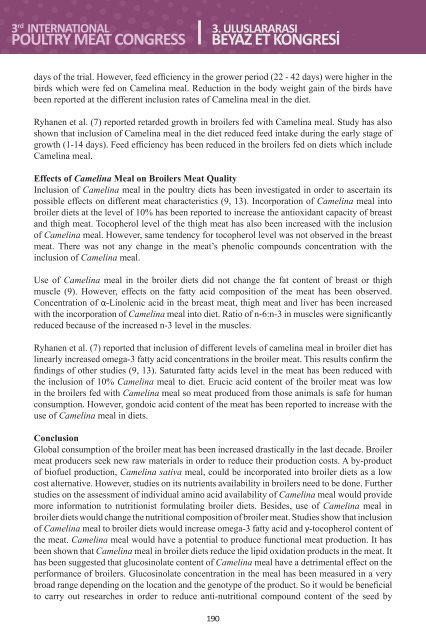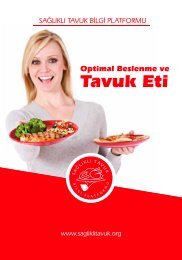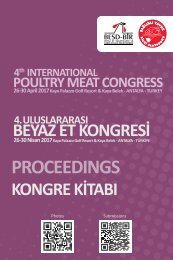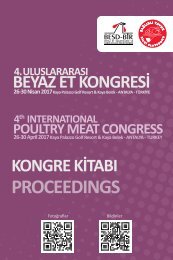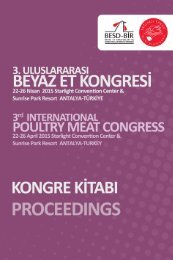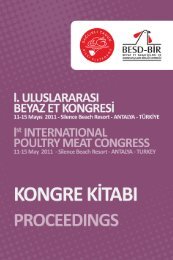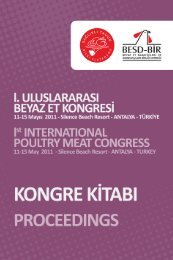3rd International Poultry Meat Congress
Proceedings
Proceedings
You also want an ePaper? Increase the reach of your titles
YUMPU automatically turns print PDFs into web optimized ePapers that Google loves.
days of the trial. However, feed efficiency in the grower period (22 - 42 days) were higher in the<br />
birds which were fed on Camelina meal. Reduction in the body weight gain of the birds have<br />
been reported at the different inclusion rates of Camelina meal in the diet.<br />
Ryhanen et al. (7) reported retarded growth in broilers fed with Camelina meal. Study has also<br />
shown that inclusion of Camelina meal in the diet reduced feed intake during the early stage of<br />
growth (1-14 days). Feed efficiency has been reduced in the broilers fed on diets which include<br />
Camelina meal.<br />
Effects of Camelina Meal on Broilers <strong>Meat</strong> Quality<br />
Inclusion of Camelina meal in the poultry diets has been investigated in order to ascertain its<br />
possible effects on different meat characteristics (9, 13). Incorporation of Camelina meal into<br />
broiler diets at the level of 10% has been reported to increase the antioxidant capacity of breast<br />
and thigh meat. Tocopherol level of the thigh meat has also been increased with the inclusion<br />
of Camelina meal. However, same tendency for tocopherol level was not observed in the breast<br />
meat. There was not any change in the meat’s phenolic compounds concentration with the<br />
inclusion of Camelina meal.<br />
Use of Camelina meal in the broiler diets did not change the fat content of breast or thigh<br />
muscle (9). However, effects on the fatty acid composition of the meat has been observed.<br />
Concentration of α-Linolenic acid in the breast meat, thigh meat and liver has been increased<br />
with the incorporation of Camelina meal into diet. Ratio of n-6:n-3 in muscles were significantly<br />
reduced because of the increased n-3 level in the muscles.<br />
Ryhanen et al. (7) reported that inclusion of different levels of camelina meal in broiler diet has<br />
linearly increased omega-3 fatty acid concentrations in the broiler meat. This results confirm the<br />
findings of other studies (9, 13). Saturated fatty acids level in the meat has been reduced with<br />
the inclusion of 10% Camelina meal to diet. Erucic acid content of the broiler meat was low<br />
in the broilers fed with Camelina meal so meat produced from those animals is safe for human<br />
consumption. However, gondoic acid content of the meat has been reported to increase with the<br />
use of Camelina meal in diets.<br />
Conclusion<br />
Global consumption of the broiler meat has been increased drastically in the last decade. Broiler<br />
meat producers seek new raw materials in order to reduce their production costs. A by-product<br />
of biofuel production, Camelina sativa meal, could be incorporated into broiler diets as a low<br />
cost alternative. However, studies on its nutrients availability in broilers need to be done. Further<br />
studies on the assessment of individual amino acid availability of Camelina meal would provide<br />
more information to nutritionist formulating broiler diets. Besides, use of Camelina meal in<br />
broiler diets would change the nutritional composition of broiler meat. Studies show that inclusion<br />
of Camelina meal to broiler diets would increase omega-3 fatty acid and γ-tocopherol content of<br />
the meat. Camelina meal would have a potential to produce functional meat production. It has<br />
been shown that Camelina meal in broiler diets reduce the lipid oxidation products in the meat. It<br />
has been suggested that glucosinolate content of Camelina meal have a detrimental effect on the<br />
performance of broilers. Glucosinolate concentration in the meal has been measured in a very<br />
broad range depending on the location and the genotype of the product. So it would be beneficial<br />
to carry out researches in order to reduce anti-nutritional compound content of the seed by<br />
190


